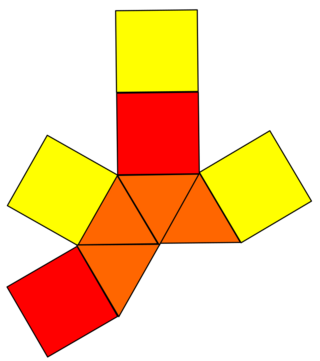Elongated square pyramid
| Elongated square pyramid | |
|---|---|
 | |
| Type | Johnson J7 – J8 – J9 |
| Faces | 4 triangles 1+4 squares |
| Edges | 16 |
| Vertices | 9 |
| Vertex configuration | |
| Symmetry group | |
| Dihedral angle (degrees) |
|
| Dual polyhedron | self-dual[1] |
| Properties | convex, composite |
| Net | |
 | |
In geometry, the elongated square pyramid is a convex polyhedron constructed from a cube by attaching an equilateral square pyramid onto one of its faces. It is an example of Johnson solid.
Construction
The elongated square pyramid is a composite, since it can constructed by attaching one equilateral square pyramid onto one of the faces of a cube, a process known as elongation of the pyramid.[2][3] One square face of each parent body is thus hidden, leaving five squares and four equilateral triangles as faces of the composite.[4]
A convex polyhedron in which all of its faces are regular is a Johnson solid, and the elongated square bipyramid is one of them, denoted as , the fifteenth Johnson solid.[5]
Properties
Given that is the edge length of an elongated square pyramid. The height of an elongated square pyramid can be calculated by adding the height of an equilateral square pyramid and a cube. The height of a cube is the same as the edge length of a cube's side, and the height of an equilateral square pyramid is . Therefore, the height of an elongated square bipyramid is:[6] Its surface area can be calculated by adding all the area of four equilateral triangles and four squares:[4] Its volume is obtained by slicing it into an equilateral square pyramid and a cube, and then adding them:[4]
File:Pirámide cuadrada elongada.stl The elongated square pyramid has the same three-dimensional symmetry group as the equilateral square pyramid, the cyclic group of order eight. Its dihedral angle can be obtained by adding the angle of an equilateral square pyramid and a cube:[7]
- The dihedral angle of an elongated square bipyramid between two adjacent triangles is the dihedral angle of an equilateral triangle between its lateral faces, ,
- The dihedral angle of an elongated square bipyramid between two adjacent squares is the dihedral angle of a cube between those, ,
- The dihedral angle of an equilateral square pyramid between square and triangle is . Therefore, the dihedral angle of an elongated square bipyramid between triangle-to-square, on the edge where the equilateral square pyramids attach the cube, is
See also
References
- ↑ Draghicescu, Mircea. "Dual Models: One Shape to Make Them All". Bridges Finland: Mathematics, Music, Art, Architecture, Education, Culture. pp. 635–640. https://archive.bridgesmathart.org/2016/bridges2016.
- ↑ Timofeenko, A. V. (2010). "Junction of Non-composite Polyhedra". St. Petersburg Mathematical Journal 21 (3): 483–512. doi:10.1090/S1061-0022-10-01105-2. https://www.ams.org/journals/spmj/2010-21-03/S1061-0022-10-01105-2/S1061-0022-10-01105-2.pdf.
- ↑ Rajwade, A. R. (2001). Convex Polyhedra with Regularity Conditions and Hilbert's Third Problem. Texts and Readings in Mathematics. Hindustan Book Agency. p. 84–89. doi:10.1007/978-93-86279-06-4. ISBN 978-93-86279-06-4. https://books.google.com/books?id=afJdDwAAQBAJ&pg=PA84.
- ↑ 4.0 4.1 4.2 Berman, Martin (1971). "Regular-faced convex polyhedra". Journal of the Franklin Institute 291 (5): 329–352. doi:10.1016/0016-0032(71)90071-8.
- ↑ Uehara, Ryuhei (2020). Introduction to Computational Origami: The World of New Computational Geometry. Springer. p. 62. doi:10.1007/978-981-15-4470-5. ISBN 978-981-15-4470-5. https://books.google.com/books?id=51juDwAAQBAJ&pg=PA62.
- ↑ Sapiña, R.. "Area and volume of the Johnson solid " (in es). Problemas y Ecuaciones. ISSN 2659-9899. https://www.problemasyecuaciones.com/geometria3D/volumen/Johnson/J8/calculadora-area-volumen-formulas.html. Retrieved 2020-09-09.
- ↑ "Convex polyhedra with regular faces". Canadian Journal of Mathematics 18: 169–200. 1966. doi:10.4153/cjm-1966-021-8.
External links
 |
